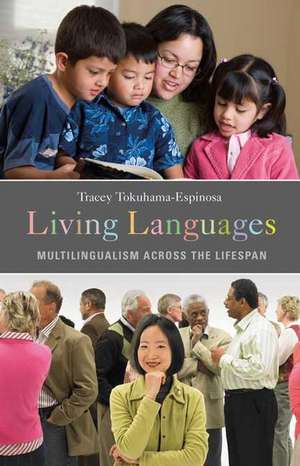Living Languages: Multilingualism across the Lifespan
Autor Tracey Tokuhama-Espinosaen Limba Engleză Hardback – 29 dec 2007 – vârsta până la 17 ani
Preț: 357.89 lei
Preț vechi: 416.36 lei
-14% Nou
Puncte Express: 537
Preț estimativ în valută:
68.50€ • 74.44$ • 57.58£
68.50€ • 74.44$ • 57.58£
Carte tipărită la comandă
Livrare economică 21 aprilie-05 mai
Preluare comenzi: 021 569.72.76
Specificații
ISBN-13: 9780275999124
ISBN-10: 0275999122
Pagini: 296
Dimensiuni: 156 x 235 x 27 mm
Greutate: 0.61 kg
Editura: Bloomsbury Publishing
Colecția Praeger
Locul publicării:New York, United States
ISBN-10: 0275999122
Pagini: 296
Dimensiuni: 156 x 235 x 27 mm
Greutate: 0.61 kg
Editura: Bloomsbury Publishing
Colecția Praeger
Locul publicării:New York, United States
Notă biografică
Tracey Tokuhama-Espinosa is Director of the Center for Educational Development in Quito, Ecuador and Professor of Education, at the University of San Francisco de Quito. She is the author of the acclaimed book, Raising Multilingual Children: Foreign Language Acquisition and Children (Bergin and Garvey, 2000) and The Multilingual Mind: Issues Discussed by, for, and about People Living with Many Languages (Praeger, 2003).
Recenzii
Tokuhama-Espinosa (director, Center for Educational Development, Ecuador) provides a resource for parents and teachers to explore linguistic, sociocultural, and neuropsychological theories of second- and third-language acquisition, including a discussion of seven life stages from birth to adulthood..This book is an invitation to parents, teachers, and policy makers to extend multilingualism across the lifespan. Recommended.
Living Languages is a comprehensive text that provides not only information about the various factors in successful language learning, but also a unique window into the influence and impact of language learning on the author's own multilingual family. This is the author's third book in which she has chosen to explore the benefits of bilingualism/multilingualism..Her book is based on over 700 studies and her own family's interactions with language development. Many of the questions that are addressed in the book were posed while she was conducting workshops with parents and educators in 15 countries, so they address practical as well as theoretical concerns.
Living Languages is aimed at parents, teachers and researchers with its practical information on the language learning process, the key factors in raising multilingual children, as well as the impact of the environment (family, schools and society) on the language-learning process.. Living Languages encourages families and educators to continue in their goal of providing children in families, schools and communities with as much language opportunities and exposure as possible, no matter how young or old they happen to be. We are shown that the lifelong emotional, social, and global benefits of multilingualism outweigh the efforts in the long run.
Living Languages is a comprehensive text that provides not only information about the various factors in successful language learning, but also a unique window into the influence and impact of language learning on the author's own multilingual family. This is the author's third book in which she has chosen to explore the benefits of bilingualism/multilingualism..Her book is based on over 700 studies and her own family's interactions with language development. Many of the questions that are addressed in the book were posed while she was conducting workshops with parents and educators in 15 countries, so they address practical as well as theoretical concerns.
Living Languages is aimed at parents, teachers and researchers with its practical information on the language learning process, the key factors in raising multilingual children, as well as the impact of the environment (family, schools and society) on the language-learning process.. Living Languages encourages families and educators to continue in their goal of providing children in families, schools and communities with as much language opportunities and exposure as possible, no matter how young or old they happen to be. We are shown that the lifelong emotional, social, and global benefits of multilingualism outweigh the efforts in the long run.


